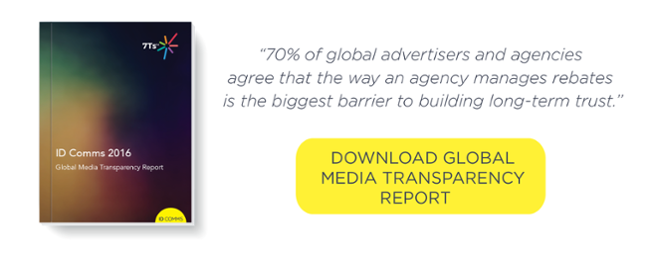Now that the dust has settled after the explosive ANA Media Transparency Report, pragmatic steps forward should be a marketers’ focus for Q4.
As the summer draws to a close and we re-focus on business and a productive Q4, brands need to consider what they are doing to address the ANA Guidelines.
It’s been a tumultuous year for media agency observers like myself. I’ve been interrogated by K2, watched a huge gulf open up between advertisers and the agencies they employ and helped countless brands start to develop the action plans they need to build new agency relationships.
At the heart of the issue is trust and transparency. Advertisers need to trust that their agency has their best interests at heart (and isn’t cutting side deals with media owners).
Download ID Comms 2016 Global Media Transparency Report
The recent revelation from The Guardian newspaper that it offers cash incentives to media agencies in return for advance commitments of client’s money should be of concern to marketers. The news doesn’t help raise already low levels of trust in media agencies.
The ANA’s report highlighted that such behaviour also occurs in the US, a market where everyone thought rebates didn’t happen.
I’ve recently spoken to a few Media Directors at major international brands who have voiced concern that, nearly three months on, senior marketing stakeholders in their company have not taken the ANA report findings and guidelines seriously enough. They were interested for a while but now seemed to have moved onto other areas. Any Media Director in this position will be trying to put the issue back onto the agenda for Q4, and be considering actions for 2017.
The ANA report highlighted some particular areas of “non-transparent business activities”, which involved different methods of passing money or added value between media vendors and media agencies:
- Incentive cash rebates paid by vendors to agencies in return for client billings
- Additional discounts or bonus (free) inventory
- Service agreements – where the vendor agrees to pay the agency for services such as research or consulting, often at inflated prices
- Marked-up pricing where the agency is taking a principal position and pre-buying media inventory, sometimes this resulted in “dual ratecards” – different pricing dependent upon whether the agency was acting as agent or principal.
For global advertisers, managing rebates is a fact of life in many markets, the challenge in the US was that no one thought it was happening. The critical question for advertisers is to what extent an agency is disclosing these arrangements, where they exist.
The 2016 Media Transparency Report found that 70 per cent of all respondents (global marketing and procurement leaders with combined media budgets in excess of $20 billion) felt that the way a media agency manages these rebates was the most important factor affecting the level of trust that advertisers have in media agencies.
No one wants this of course and at the heart of the solution, lie three key things:
Firstly, advertisers must assign more importance to media. Marketers need the internal talent and skills to take back some control of media investment and hold it to account for business growth. Too many brands have let this expertise wither.
Secondly, ensure a strong contract exists, with defined targets, that sets up the agency to be rewarded when it delivers and puts everyone’s rights and responsibilities in writing.
Thirdly, identify or recruit a clear leader for media, someone who can celebrate media’s power to drive business growth right across the C-suite, while also managing the detail needed to improve use of digital channels and monitor agency performance.
Changes will not be immediate but gradual The first step for many Media Directors will be to identify what their company wants media to do, only then can they assess whether they have the right contract or are working with the right agencies in the right way.
For those brands that have only just started down this road, or those trying to refocus their senior marketing stakeholders, the time to take action will be now and into Q4.







COMMENTS